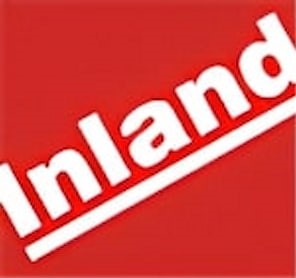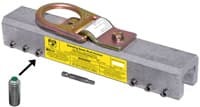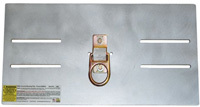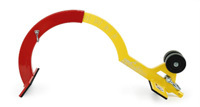Fall Protection For Inland Buildings Roof Systems
Posted by Howie Scarboro - CEO Fall Protection Distributors, LLC on Sep 9th 2024
See the Roof Anchor Compatibility Chart for Inland Building Systems Standing Seam Panels.

Who Is Inland Buildings?
Inland Building Systems is one of the oldest and most respected names in the metal building industry, dating back to 1910. Originally part of Inland Steel Corporation and headquartered in Deerfield, Illinois, the company has evolved significantly. Inland Steel merged its metal building division with Ryerson Corporation, forming Inland Ryerson, or INRYCO, which led to the establishment of a manufacturing facility in Cullman, Alabama, in 1974.
Inland Building Systems operated under the INRYCO name until 1986, when Inland Steel decided to divest its metal building business. The company was then purchased by the financial group Dubin and Clark, signaling a new growth phase.
In 1996, Behlen Manufacturing Company acquired Inland's assets and continued operations until September 2008, when Schulte Building Systems took ownership. The Schulte name, known for its commitment to quality and customer service, has significantly influenced the metal building industry for over half a century. Today, as part of Schulte Building Systems, Inland continues to deliver high-quality, custom-engineered metal building systems with a strong focus on customer satisfaction.
Based in Cullman, Alabama, Inland Building Systems has been a significant supplier in the metal building industry for over sixty years. The company has supplied buildings to all fifty states and over thirty foreign countries. Inland has many nationally recognized clients, including Coca-Cola, Ford Motor Company, Anheuser-Busch, and the United States Armed Forces. These clients repeatedly choose Inland because they trust the durability and performance of their building systems.
From the initial inquiry to the final project completion, Inland Building Systems ensures projects are delivered on time and within budget. Their versatile product line includes standing seam roof systems and other building components. Inland's commitment to excellence has made them a trusted partner in the metal building industry for over four decades.
What Is The Most Compatible Fall Protection For Inland Roofs?
Specialized fall protection is essential when working on standing seam roofs to ensure safety and maintain the roof's integrity. Standing seam roofs, known for their durability and weather resistance, lack exposed fasteners, which can complicate the installation of traditional fall protection systems.
The SSRA1 Standing Seam Roof Anchor, SSRA2 Adjustable Roof Jack Adapter, and SSRA3 Anchor Plate are excellent choices for Inland Building Systems' roofs. These products offer secure attachment points without penetrating the roof surface, preserving its integrity while providing a reliable anchor for lifelines and lanyards. Additionally, the Ridge Pro Steep Assist is well-suited for roofs with slopes ranging from 6/12 to 12/12, offering a safe and dependable solution for steeper pitches.
By selecting the appropriate fall protection equipment, companies can ensure worker safety while maintaining the quality and aesthetics of Inland's standing seam roofs.
TS-324 Panel Description

The TS-324 Standing Seam Roof System offers performance, reliability, and cost efficiency. With its 3-inch seam height and 24-inch panel width, this system provides superior protection against wind and weather across various roof loading conditions. The TS-324 features a patented seam proven to withstand harsh environments, making it a dependable choice for different building projects. See the Roof Anchor Compatibility Chart for Inland Building Systems TS-324 Standing Seam Panels.
One of the key strengths of the TS-324 system is its adaptability. This roof system accommodates all three roof weather zones by utilizing one of three seaming shapes formed on-site. This flexibility allows for precise adjustments to meet specific wind-loading requirements without extra materials or changes to panel and purlin placements. The result is a streamlined installation process, consistent purlin spacing, a single panel size, and one type of clip, leading to faster construction and reduced overall costs.
The TS-324 panels are made from standard 24-gauge material and are available in Galvalume®, Ceram-A-Star® 950, and Fluropon® 70% Kynar finishes. These finishes provide durability and long-lasting aesthetic appeal, ensuring the panels maintain performance and appearance over time.
The TS-324 system is certified for Underwriters Laboratories UL-90 Classification Construction No. 562, the Corps of Engineers CEGS 07416 Uplift Test, the ASTM E 1592 Uplift Test, and tests for air infiltration and water leakage. These certifications demonstrate the TS-324's ability to meet stringent standards for wind uplift and air and water resistance, making it a solid choice for various applications.
The TS-324 offers three seaming options, each tailored to specific environmental challenges. The Roll-and-Lock seam involves hand-seaming at each clip, providing excellent water resistance by keeping the sealant secure even in severe winds. This simple process requires just one rotation of the hand seamer at each clip, locking the panel to the roof structure.
The Triple-Lock seam, achieved with an electric seamer, offers additional protection for more demanding conditions. This method uses a 360° plus 90° seam, isolating the seam structurally to withstand severe wind loading. Thanks to a specialized electric seamer, the Quadri-Lock seam provides even greater strength in high wind areas, with uplift loads ranging from 64 to 120 PSF.
Fall Protection for TS-324 Panels
Ensuring safety on the TS-324 panels involves using the right combination of fall protection solutions. The SSRA1 Standing Seam Roof Anchor is the foundation, offering a secure attachment point for lifelines and lanyards by clamping directly onto the standing seams without penetrating the roof surface. This setup preserves the roof's integrity while providing reliable fall protection.
The SSRA2 Adjustable Roof Jack Adapter adds versatility, allowing for flexible positioning of roof jacks to accommodate different roof slopes and seam heights. For projects requiring maximum mobility, especially when multiple workers are involved, the SSRA3 Anchor Plate mounts on top of the SSRA1 anchors. This setup creates a solid attachment point for temporary horizontal lifelines, enabling workers to move freely across the roof while securely tethered.
For steeper roofs, particularly those with slopes ranging from 6/12 to 12/12, the Ridge Pro Steep Assist is an essential component. It ensures secure attachment on challenging inclines, keeping workers safe in demanding environments. These fall protection solutions work seamlessly with the TS-324 panels, providing a comprehensive safety system that adapts to various roofing scenarios, ensuring worker safety and maintaining the roof's high standards.
VS-216 Panel Description

The VS-216 (Vertical System) standing seam panel provides exceptional wind and weather protection under all roof loading conditions. It is available in 22—or 24-gauge steel, has a 16-inch panel width, and is durable in finishes such as Galvalume Plus and Kynar 500. See the Roof Anchor Compatibility Chart for Inland Building Systems VS-216 Standing Seam Panels.
Recent changes in wind uplift resistance requirements and testing methods have driven the need for a new approach to roof performance. While many manufacturers have responded with temporary fixes, the VS-216 system introduces a new, patented technology that meets and exceeds these stringent standards. This breakthrough in seaming technology ensures superior wind and water resistance and maintains an aesthetically pleasing architectural design. The result is a metal roof that leads the industry in performance, reliability, and cost efficiency.
The VS-216 panel system uses the TripleLok™ seam, created by seaming the entire seam with an electric seamer. This unique seam design offers an allowable wind uplift loading of 48 psf. It is the only seam on the market featuring a 360° plus 90° seam, which provides several benefits. The seam structurally isolates the seam from the effects of severe wind loading by placing load-resisting bends between the seam and the stresses of panel deflection. The seam sealant is also protected from dislodgment or separation during severe winds, ensuring water resistance throughout the roof's lifespan.
For areas with extremely high winds, such as coastal regions, the QuadLok™ seam is available. This seam, also created with an electric seamer, provides an even higher allowable uplift load of 63 psf, or 97 psf, over 2'6" purlin spacing. The QuadLok seam allows roofs in high-wind coastal locations to resist wind loads without needing exterior clamps and brackets. Notably, the QuadLok seam offers higher uplift resistance with a 24-gauge panel than many other systems achieve with 22-gauge panels.
The VS-216 panels feature a 360-degree Pittsburgh Seam, formed by locking the male and female seams together with a specialized, electrically powered mechanical seamer. These seaming tools are exclusively available from Inland Buildings, ensuring precise and reliable installation. The panels are attached to the roof's secondary members using clips at every purlin, joist, and sub-purlin, though not on purlin struts. The panels are factory-notched at both ends, allowing installation to start or end from either side of the building.
Regarding finishes, the VS-216 is offered in Kynar 500 and Galvalume Plus, providing long-lasting protection and aesthetic appeal. Inland Building Systems also backs the VS-216 with several weather-tightness warranties, including a Limited and a Premium Warranty.
Fall Protection for VS-216 Panels
Ensuring the safety of the VS-216 panels involves using proper fall protection solutions. The SSRA1 Standing Seam Roof Anchor offers a secure attachment point for lifelines and lanyards by clamping directly onto the standing seams without penetrating the roof surface, preserving the roof's integrity. This anchor is the foundation for a reliable fall protection system, providing the necessary safety for workers during installation and maintenance.
To enhance this setup, the SSRA2 Adjustable Roof Jack Adapter allows for flexible positioning of roof jacks, accommodating various seam height and roof pitch. The SSRA3 Anchor Plate, which mounts on top of the SSRA1 anchors, provides a solid attachment point for temporary horizontal lifelines. This setup is especially beneficial when maximum mobility is required for multiple workers, as it allows them to move freely across the roof while staying securely tethered.
For roofs with steeper slopes, particularly those ranging from 6/12 to 12/12, the Ridge Pro Steep Assist is an essential addition. It ensures a secure attachment on challenging inclines, maintaining worker safety in demanding environments. Together, these fall protection solutions work in harmony with the VS-216 panels, offering a comprehensive safety system that adapts to various scenarios while ensuring the high standards of the roof system are maintained.
Standing Seam Metal Roof Anchor Panel Compatibility Chart For Inland Building Systems
| Inland Building Systems | TS-324 Panel | VS-216 Panels |
|---|---|---|
| YES | YES | |
| YES | YES | |
| YES | YES | |
| YES | YES | |
| YES | YES |
Get in Touch for More Information
We'd love to hear about your project! Call us at (863) 703-4522 to discuss your requirements, or visit our website at www.StandingSeamRoofAnchor.com for more information. For additional details on fall protection, consult OSHA's comprehensive 48-page manual. Once you have determined the most suitable anchor system for your roof, download our Anchor Inspection Form.
Safety Tips For Metal Roof Work
Prioritize Safety with Regular Inspections and Training
You must inspect safety equipment regularly to avoid accidents. Workers should also have regular training sessions to stay current on fall protection procedures and equipment use. Ongoing attention to these areas helps prevent accidents and ensures that safety standards remain high.
Equip Workers with High-Quality Safety Gear
Provide your crew with premium full-body harnesses and shock-absorbing lanyards. These essential tools reduce the impact force during falls, significantly lowering the risk of severe injuries.
Use Footwear Designed for Stability
Ensure workers wear non-slip footwear designed for metal roofs and avoid working on wet surfaces. The right shoes improve stability and reduce the likelihood of slips and falls.
Plan with an OSHA-Compliant Safety Strategy
Before starting any project, develop a comprehensive safety plan that complies with OSHA regulations and includes clear rescue procedures. Proper planning is vital for protecting workers in emergencies.
Secure Ladders and Scaffolding Properly
Ensure ladders and scaffolding are stable, free from obstructions, and correctly positioned. Enhance safety by following the 4-1 ladder placement rule and implementing OSHA-compliant ladder safety training.
Highlight the Importance of Trauma Straps
Safety trainers should teach workers the importance of trauma straps with their harnesses. These straps prevent suspension trauma after a fall, which can be life-threatening if not managed quickly.
Establish Secure Work Zones on Roofs
Install guardrails, warning lines, or protective barriers on low-slope roofs to define work areas. These measures help reduce fall risks and create a safer working environment.
Exercise Caution on Curved Roofs
Avoid using seam-mounted anchors on curved metal roof panels. A safety expert should evaluate the site and create a plan to address the specific hazards of working on curved surfaces.
Use Roof Anchors Designed for Standing Seam Roofs
Select roof anchor systems intended for standing seam roofs, avoiding those that must attach over roof clips. These clips can be difficult to locate on existing roofs, which could compromise safety.
Consider Permanent Roof Anchor Systems
Invest in permanent roof anchor systems for future maintenance and inspections. These systems offer long-term safety and ensure ongoing protection for workers.
Disclaimer
The views, recommendations, and information presented in this blog are solely those of the author and do not necessarily reflect the opinions or positions of the featured panel manufacturer, its brands, subsidiaries, or parent companies. Customers are strongly encouraged to contact the roof panel manufacturer directly with inquiries.






